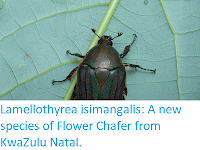Clown (of Hister) Beetles, Histeridae, are a diverse group of carnivorous Beetles found across the globe. They are easy to distinguish, the elytra (wing cases) that do not cover the ends of their abdomens and club-like tips to their antennae. They occupy a wide range of ecological niches, with most species feeding on other Arthropods and small invertebrates, though other specialise in the carrion of larger animals (and in some cases are used by forensic entomologists to help determine how long bodies have been dead). The group has a reasonable fossil record, with numerous fossils, predominantly in amber, from the Oligocene onwards, and two previously described specimens from Cretaceous Burmese Amber, though these are not for the most part well studied and the origins of the group are obscure.
In a paper published in the journal ZooKeys on 1 February 2018, Michael Caterino of the Department of Plant & Environmental Sciences at Clemson University and David Maddison of the Department of Integrative Biology at Oregon State University, describe a third species of Clown Beetle from Burmese Amber.
Cretaceous ‘Burmese Amber’ has been extensively worked at several
sites across northern Myanmar (though mostly in Kachin State) in the
last 20 years. The amber is fairly clear, and often found in large
chunks, providing an exceptional window into the Middle Cretaceous
Insect fauna. This amber is thought to have started out as the resin of a
Coniferous Tree, possibly a Cypress or an Araucaria, growing in a moist
tropical forest. This amber has been dated to between 105 and 95
million years old, based upon pollen inclusions, and to about 98.8
million years by uranium/lead dating of ash inclusions in the amber.
The new species is named Amplectister tenax, where 'Amplectister' means 'Hugging Hister' and 'tenax' means 'tenacious'. The species is described from a single specimen of indeterminate sex, 1.41 mm in length and 1.02 mm in width, with an elongate, flattened body. This appears to have a granular texture, and has trapped a layer of either some granular substance or small air bubbles on its surface.
Photographs of Amplectister tenax. (2) Ventral view. (3) Dorsal view. (4) Lateral view. (5) Frontal view. Caterino & Maddison (2018).
See also...







